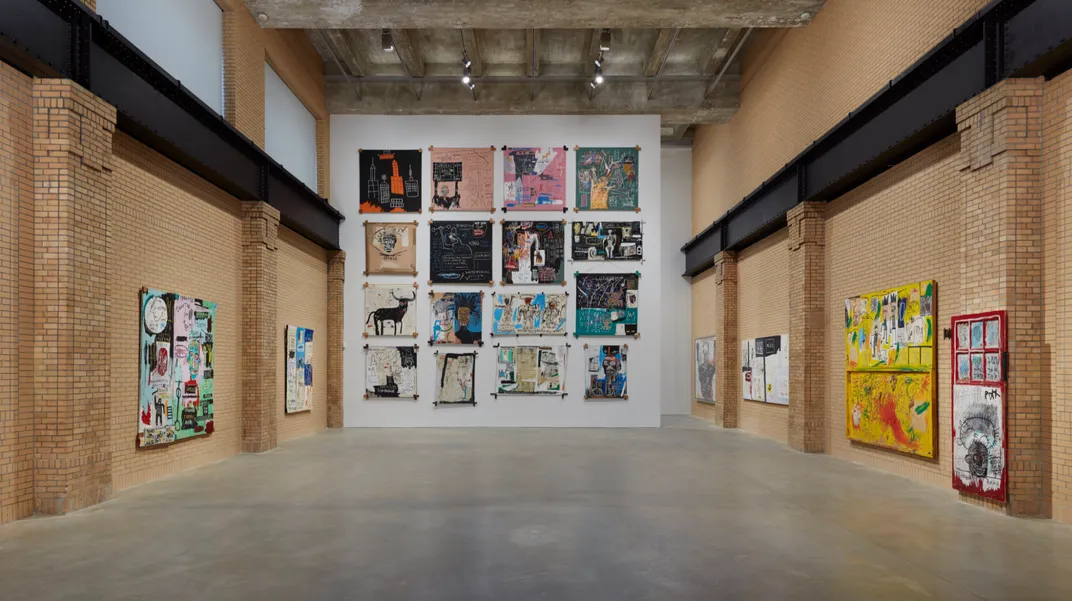See Jean-Michel Basquiat Masterpieces Up Close in This Online Exhibition
The virtual experience spotlights a 2019 show that included around 70 works by the artist
:focal(2855x1389:2856x1390)/https://tf-cmsv2-smithsonianmag-media.s3.amazonaws.com/filer/37/b2/37b2cdc8-6ab8-4a67-a35a-fda770ef87e4/gettyimages-131990117.jpg)
American artist Jean-Michel Basquiat lived a short but prolific life, producing more than 1,000 paintings and 2,000 drawings in less than a decade. Thanks to his bold, Neo-Expressionist paintings, which dealt with themes of colonialism, genius, race, creativity and oppression, he quickly rose from humble beginnings in the underground graffiti scene to stardom in the white-dominated art world of 1980s New York City.
Basquiat died of a heroin overdose in 1988 at just 27 years old. But the art world’s enthusiasm for his works continued to soar in the decades following his passing. Last year, the Brant Foundation Art Study Center in Manhattan’s East Village united almost 70 of the artist’s paintings in “Jean-Michel Basquiat,” a major solo exhibition on view from March 6 to May 14.
Now, art enthusiasts can take a free virtual tour of the show via the foundation’s website, reports Thom Waite for Dazed. Highlights include some of Basquiat’s largest works, including Grillo (1984) and Price of Gasoline in the Third World, a 1982 creation that tackles issues raised by colonization.
/https://tf-cmsv2-smithsonianmag-media.s3.amazonaws.com/filer/cf/46/cf4638c5-3d5d-41de-bcf8-f32248bc8863/screen_shot_2020-07-27_at_111207_am.png)
The 2019 show took place in a renovated former Con Edison power substation near Basquiat’s old stomping grounds, reviewer Phoebe Hoban pointed out for Vulture last March. One of Basquiat’s first breakthrough exhibitions—a 1982 show at the FUN Gallery—took place just a few blocks away.
As Martha Schwendener observed in the New York Times’ review of of “Jean-Michel Basquiat,” gentrification has rendered the East Village the artist knew virtually invisible.
“It’s great to see Basquiat in the East Village—although, with its new condominiums, steep rents, and expensive restaurants, it barely resembles the neighborhood he inhabited 40 years ago,” she wrote.
Curator Dieter Buchhart oversaw the 2019 exhibition, which was organized in collaboration with Fondation Louis Vuitton and included works from industrialist and newspaper tycoon Peter Brant’s personal collection. Brant was an early collector of Basquiat’s works, and he later purchased Interview magazine, which Andy Warhol famously co-founded in 1969. (Basquiat and Warhol were close friends, enjoying a “profoundly symbiotic and mutually beneficial creative relationship,” according to Sotheby’s.)
“Basquiat’s complex oeuvre has established him as one of the most important innovators in modern art, even thirty years after his death,” said Brant in a 2019 statement. “Numerous recent retrospectives have spotlighted his radical approach, illuminating his interdisciplinary contributions to music, poetry, performance, and art and cementing him as one of the most forward-thinking artists of his generation, whose complex engagement with social and political questions makes him more relevant than ever.”
The artist was known for scribbling words and phrases, often deliberately misspelled or crossed out, in his paintings. Numerous examples of this practice appear in the 2019 exhibition.
Untitled, a 1982 work that depicts a grimacing skull rendered in thick black lines in front of an electric blue background, hangs in a corner on the second floor of the show. In 2017, Japanese billionaire Yusaku Maezawa made headlines by bidding $110.5 million for the canvas, which became the most expensive work by an American artist ever purchased at auction, as Brigit Katz reported for Smithsonian magazine at the time.
Writing for artnet News in 2018, Ben Davis described Untitled as a deliberate evocation of “the look of defaced subway walls or bathroom stalls; mark-making that is public but also unsanitized, and in guerrilla competition for your attention.”
He concluded, “In a way, Untitled (1982) is built to be what it has become, a high-energy icon that can spread easily as a media image. But at the same time it also whispers that it doesn’t want to be reduced to just that; it doesn’t just want to be looked at, it wants to be seen.”
/https://tf-cmsv2-smithsonianmag-media.s3.amazonaws.com/accounts/headshot/nora.png)

/https://tf-cmsv2-smithsonianmag-media.s3.amazonaws.com/filer/72/c1/72c123b9-9a6d-482f-82c3-e47e4e3a722a/screen_shot_2020-07-26_at_70119_pm.png)
/https://tf-cmsv2-smithsonianmag-media.s3.amazonaws.com/accounts/headshot/nora.png)